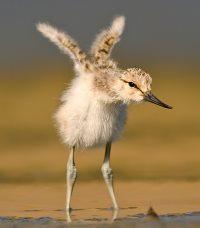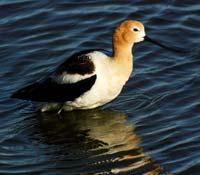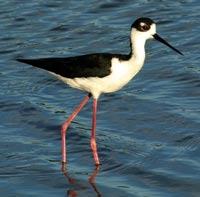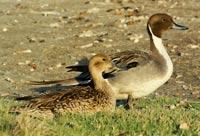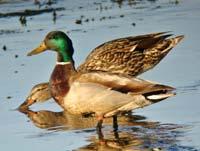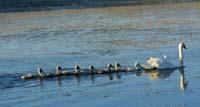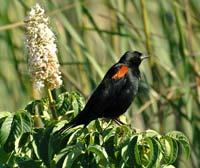Local Birding Sites: Sonoma County
Shollenberger Park (Petaluma)
Ellis Creek Ponds (Petaluma)
Shollenberger Park- Scott Carey, June 15, 2013 In Sonoma County, Bodega Bay is well known for its excellent birding for wintering waterfowl, gulls, shorebirds and other wetland birds. Only Shollenberger Park rivals it if not in number of birds but in diversity. Shollenberger Park, which older birdwatchers know as the Cader Lane Ponds, is a special place for local birdwatching enthusiasts. The park’s main attraction for birds and bird watchers is the large impoundment or pond. Due to its location nearby the tidal Petaluma River, many birds use the pond to loaf out the hours during high tide, feed, spend the winter months, or breed here. Birding here any month of the year is good, but the best time is in the fall and winter months. Year round birds to see here are the American Avocet, Black-necked Stilt, Snowy Egret, Great Egret, Mallard, Ruddy Duck, Northern Shoveler, White Pelican, Mute Swan (introduced species), Canada Goose, Red-winged Blackbird, Great-tailed Grackle, Marsh Wren, and Song Sparrow. It is in the fall though that bird activity here really gets ramped up. Shorebirds (in the hundreds, sometimes thousands) will use the pond and mudflats for feeding and resting as they journey south. Western Sandpipers, Least Sandpipers, Whimbrel, Long-billed Curlew, Semipalmated Plover, Marbled Godwits, Greater and Lesser Yellowlegs, Long-billed Dowitchers, Black-bellied Plovers, Red-necked Phalaropes, and Wilson’s Phalaropes are some of the main shorebirds that use this park. As fall turns to winter some shorebirds stay and wintering waterfowl and gulls join them. It’s very easy to see both Lesser and Greater Scaup, Northern Pintail, American Wigeon, Bufflehead, Green-winged Teal, Canvasback, Horned Grebe, Eared Grebe, Western Grebe, Pied-billed Grebe, American Coot, and others. Raptor viewing here is best in winter with Red-tailed Hawk, Red-shouldered Hawk, White-tailed Kite, Northern Harrier, and American Kestrel seen in nearby fields hunting. Occasionally a Peregrine Falcon will strafe the shorebird flocks. Winter is also the time to inspect the large gull flocks for an unusual or rare gull. Western, Glaucous-winged, Ring-billed, and California Gulls are here in large numbers and ages, so it’s a great place to learn them, then look for the less common Herring, Bonaparte’s, Thayer’s, or Glaucous Gulls. Over the years some rare birds have spent time here during migration. White-faced Ibis, Pectoral Sandpiper, Sharp-tailed Sandpiper, Semipalmated Sandpiper, Tufted Duck, American Golden Plover, Pacific Golden Plover, Clay-colored Sparrow, Glaucous Gull are a few recent examples. Binoculars will be needed here as they would be for birdwatching anywhere else. Bring a spotting scope (or better yet a friend with one!) for even better coverage and viewing. Saying that, many Shollenberger Park birds allow very close viewing as they have adjusted to many people using the main trail around the ponds. This is a great location for close up bird photography. Shollenberger Park in Petaluma is easily accessed via Lakeville Highway about 1 mile east of Highway 101. For helpful maps and location information, visit Colin Talcroft's useful website on Sonoma County birding. - Go to the index of Sonoma birding sites or our Birding Sites Homepage - |
Go soon to see ducklings and young birds of many species, such as this American Avocet chick. Photo by Howler-Cat. |
|
American Avocet. Photo by Scott Carey. |
|
|
Black-necked Stilt. Photo by Scott Carey. |
|
|
Northern Pintail. Photo by Scott Carey. |
Ellis Creek Wetlands- Scott Carey, September 9, 2013 The Ellis Creek wetlands opened in 2009, created by the Ellis Creek Sewage facility for the filtering of treated water before it goes into the Petaluma River. Though oddly out of place in the tidal flood plain of the Petaluma River, this freshwater habitat has attracted many wetland birds and passerines (land birds) since it was created. Like Shollenberger Marsh to the northeast, birdwatching here is rewarding at any season. A foot trail connects the two and as at Shollenberger many of the birds here allow close viewing opportunities. Water is always high on the tule/cattail-lined ponds with many openings to see the birds through spring and summer months, offering up easy sightings of Mallard, Cinnamon teal, Common Gallinule, Mute Swan (this invasive bird is hard to miss here!), American Coot, and Pied-billed Grebe. Red-winged Blackbirds are ever present and you can often Great-tailed Grackles which nest in the tules—one of the most northerly colonies in California. Often heard but harder to see, Common Yellowthroat and Marsh Wrens also nest here. Rails including Virginia Rails and Sora can be seen or heard here at the Ellis Creek ponds and there are Clapper and Black Rails in the nearby tidal areas of the Petaluma River. Fall and winter months are good here too, though a little slower than the spring months. Waterfowl species such as Ruddy Duck, Ring-necked Duck, Bufflehead, Wood Duck, and maybe even a Hooded Merganser are all possibilities. In the uplands along the edges of the ponds, keep your eye out for Western Kingbirds, American Goldfinch, Savannah Sparrow, Bullock’s Oriole, and Tree Swallow, all of which are local summer breeders here. In the Eucalyptus trees there is often an active Red-shouldered Hawk nest and the Barn Owl Box is often occupied. Ellis Creek Wetlands is well worth a visit and with Shollenberger a stone’s throw away, you can spend the whole day here. Ellis Creek Wetlands can be accessed at the end of Cypress Drive in Petaluma. The Ellis Creek ponds in Petaluma are adjacent to Shollenberger Park profiled above. For helpful maps and location information, visit Colin Talcroft's useful website on Sonoma County birding. - Go to the index of Sonoma birding sites or our Birding Sites Homepage - |
Mallards - Photo by Scott Carey |
|
Mute Swan Family - Photo by Scott Carey |
|
|
Red-winged Blackbird - Photo by Scott Carey |


